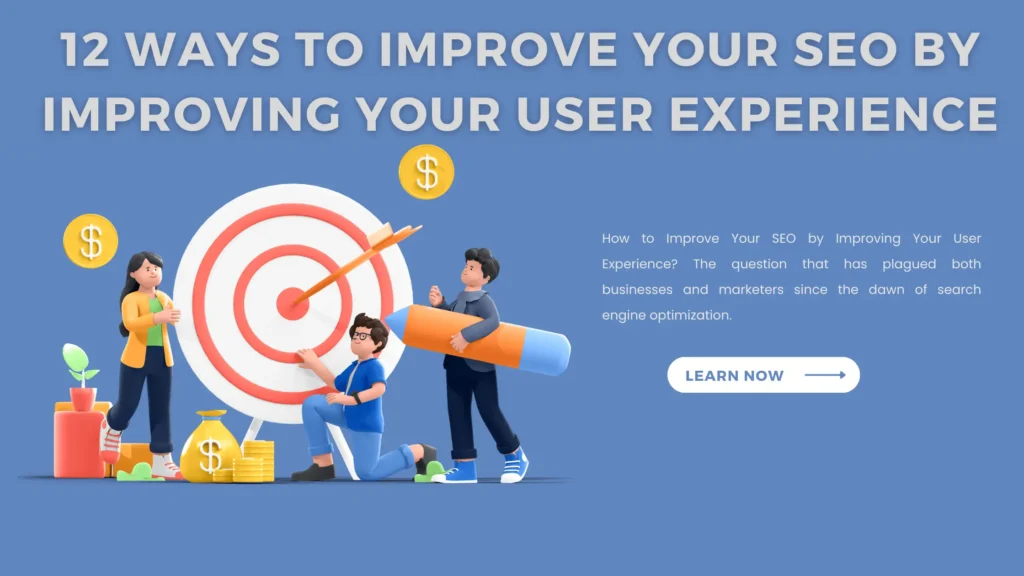How to Improve Your SEO by Improving Your User Experience? The question that has plagued both businesses and marketers since the dawn of search engine optimization.
To address this question, we’ve compiled nine ways you can enhance your website’s user experience (UX) to not only improve your website’s search engine optimization (SEO) but also increase user engagement and conversion rates as well.

12 Ways to Improve Your SEO by Improving Your User Experience
Check out our 12 lists below! For all the details, keep reading all these points carefully and implementing them into your website.
1) Fixing Crawl Errors
Crawl errors are problems that prevent Googlebot from being able to reach your pages. These errors can be caused by a number of things, including robots.txt file issues, incorrect URL redirects, and 404 errors. You can find and fix crawl errors in your Google Search Console.
Here's how to fix crawl errors in the different parts of your website.
First, go to Crawl > Crawl Errors on the left side of your dashboard. Find an error and click on it. The page will open up with more information about the problem that needs to be fixed for Googlebot to find your page again. Fix any necessary changes on this page before continuing down below.
Second, Then scroll down until you see Get notification when this issue is resolved. Check this box so you'll know when everything is fixed! Finally, return back up to where you were and go through each issue one at a time until they're all fixed!
You May Also Like: Free Keyword Research Tools || Top 10 Free Keyword Research Tools
2) Fix Your Website Content alignment
Your website content must be easy for both users and search engine crawlers to understand. If your content is not well-aligned, it can negatively impact your SEO. Here are 12 ways you can improve your content alignment:
- Make sure your website's title and meta tags are relevant to your content.
- Use keyword-rich titles and descriptions to help improve your ranking in SERPs.
- Use headings and subheadings to break up your content and make it easier to read.
- Use bullet points or numbered lists to make your content easier to scan.
- Highlight important keywords or phrases with bold or italicized text.
- Break paragraphs into shorter sentences using a new line when possible.
- Keep sentences short and to the point.
- Remove any extra white space that isn't necessary such as blank lines between paragraphs or around images on the page.
- Ensure that the content of one page doesn't lead readers down a rabbit hole of links from one page to another; always include links back to the original page at the top of each subsequent page with every change in topic, theme, name, etc., especially if you've included more than two pages worth of information on a given topic in order to give readers more options about where they want to go next on your site (but never include more than three levels deep).
- Avoid including too many links within the body of your content unless they're essential to understanding what you're talking about because doing so could distract visitors from what you have to say.
- Give your visitors plenty of navigational tools such as menus, tabs, and pagination so that they don't need to scroll through everything on their screen in order to find what they're looking for—or else use breadcrumbs so that visitors know how far along in the hierarchy of content they are at all times.
- Be consistent throughout all aspects of your design – typography, color scheme, layout—so that it feels coherent and like one seamless experience.
3) Speeding Up Load Times
In today's world, people are used to instant gratification.
If your website takes more than a few seconds to load, you're likely losing visitors.
Speed is a ranking factor for Google, so it's important for both your SEO and your user experience to have a fast website.
There are a few ways you can speed up your website, including using a content delivery network, optimizing images, and minifying CSS and JavaScript files.
You should also make sure you have a good hosting provider that can give you the resources you need to run a fast website.
You May Also Like: Sitemap Generator || Top 5 Site To Generate Your Site Map
4) Content Delivery
In order to improve your SEO, you need to focus on delivering a better user experience. Here are 7 ways you can do that:
- Make sure your website is responsive and mobile-friendly.
- Use clear and concise language throughout your website.
- Structure your content in an easy-to-read format.
- Incorporate imagery and videos into your content to break up text and add visual interest.
- Use external sources to supplement your content and add credibility.
- Promote your content through social media and other channels.
- Keep your website updated with fresh content on a regular basis.
5) Featured snippets
Featured snippets are a great way to improve your website's SEO. By providing an answer to a user's question, you can help your website rank higher in search results. Plus, featured snippets can help improve click-through rates and organic traffic.
Here are 8 ways you can improve your website's user experience and SEO:
- Make sure your website is mobile-friendly.
- Use responsive design.
- Optimize your website for speed.
- Use clear and concise copy.
- Use images and videos wisely.
- Implement schema markup.
- Create compelling content.
- Promote your content through social media and email marketing.
6) Schema Markup
Schema markup is code (semantic vocabulary) that you add to your website to help the search engines return more informative results for users. The two most common schemas are JSON-LD and Microdata, but there are many others such as RDFa, ATOM, etc.
The goal of schema markup is to provide a better understanding of what a webpage contains. Search engines will use this information to provide more accurate and detailed listings in their search engine result pages when a user queries for relevant content on your site or webpages with similar content.
You May Also Like: The Best 5 Free Backlink Checker to Check Site Backlink
7) Image optimization
Your website’s images are an important part of your overall user experience. Not only do they help break up text and add visual interest, but they also play a role in your site’s search engine optimization (SEO). Implementing the following tips will not only improve your SEO rankings but will also give you the best possible user experience.
1) Optimize all of your images with the proper tags for page titles and alt tags so that Google can understand what is inside each image.
2) Limit how many high-resolution pictures you use on one page to three or four per page in order to load faster for mobile users on slow connections.
3) Prioritize these high-resolution pictures when deciding which ones should be used as thumbnails for posts or pages; using larger ones for bigger screens makes more sense than using smaller ones for mobile screens.
8) Asking for Reviews
One way to improve your SEO is to ask your visitors for reviews. This can be done in a number of ways, such as through email, social media, or on your website. Asking for reviews not only helps improve your SEO but also helps improve your user experience.
Reviews can provide valuable feedback that you can use to make changes to your website or business. Plus, they can help build trust with potential customers.
9) Video optimization
Use video to improve your website’s user experience and, as a result, your SEO. Here are 7 ways to do it:
- Use video to introduce yourself and your team
- Use video to explain your products or services
- Use video testimonials from happy customers
- Use explainer videos to teach viewers how to use your product
- Use how-to videos to show viewers how to do something related to your product
- Use webinars to provide valuable content and build relationships with potential customers
- Use live video to show the human side of your business
You May Also Like: How To Make Money Online For Beginners
10) Mobile optimization
In 2022, more people will use their mobile devices to access the internet than ever before.
This means that if you want your website to be seen by as many people as possible, you need to make sure it is optimized for mobile devices.
One way to do this is to make sure your website loads quickly on mobile devices.
Another way to optimize your website for mobile devices is to make sure the design is responsive and easy to navigate on a small screen.
You should also consider using AMP (Accelerated Mobile Pages) to improve the loading speed of your website on mobile devices.
11) Index Now protocol
Index Now protocol is a new standard for how pages and posts are indexed on the web. By improving the user experience, you can improve your SEO and position yourself better in search engine results pages. Here are 7 ways to do just that:
- Make your site faster and more responsive.
- Improve your content quality and quantity.
- Increase your social media activity and engagement.
- Optimize your website for mobile devices.
- Use Schema markup to improve your chances of appearing in rich snippets.
- Use alt tags to describe your images for better indexing and ranking.
- Take advantage of Google Authorship to link your content to your Google+ profile.
You May Also Like: 14 Common Mistakes When Creating And Promoting Pinterest Pins
12) Create Dofollow Backlinks
One way to improve your SEO is by creating do-follow backlinks. Dofollow backlinks are when another website links to yours and passes along link juice or ranking power. This helps because the more high-quality websites that link to yours, the more authoritative your site appears in Google’s eyes. Not to mention, it also drives traffic from the linking site to yours.
Conclusions
If you want to improve the SEO and user experience of your entire website then this is the right post for you. If you want to improve your SEO then read these 12 tips carefully and implement them into your website then you can see the changes after some time.
If you think any point I should be added here then please write the points in the comment box then I will definitely add these points too.









